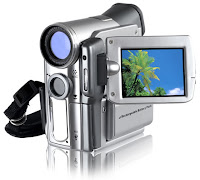Create your video using Movie Maker
 Of course, exactly how you create your video will depend upon which photo slideshow or video editing software you are using. Refer to the software instructions for the applicable procedures.
Of course, exactly how you create your video will depend upon which photo slideshow or video editing software you are using. Refer to the software instructions for the applicable procedures.- Import your images.
Select all of the images in your image folder for import.
- Add your images to the storyboard.
Use the numbers in the image names to make sure that all of the images are in the correct order.
Tip Save your video project file as you complete each step to preserve your changes. Once all of your edits are complete, you’ll use this file to create the actual video file.
- Add transitions between the images (if your software has this capacity).
Important Do not set any transition between the frames of a single complex animation. Transitions will break up the illusion of motion.
- Add other effects, if desired.
Many programs allow you to add not only transitions, but other effects such as text, titles, credits, and so on.
- Adjust timings for images and transitions.
Set both the amount of time that you want each image to remain on the screen and the duration of transitions between images. (Many programs do a good job of setting these values for you automatically.)
The process for adjusting individual slide timings varies from program to program. Most of the applications I am familiar with require that timings be adjusted in timeline view instead of storyboard view. In timeline view, you simply drag one side of an image or transition to lengthen or shorten its duration.
Tip For complex animations, set each image to display for .25 seconds, and also set each transition to .25 seconds. These settings fool the eye into perceiving a moving image.
Note that in some programs, if you want to add narration, you must record it separately and then add it as a sound file.
Important It's very important to adjust all timings for your images and transitions before you add any sound. If you adjust timings after adding sound, the sound will be distorted accordingly — dragged out or sped up — in the adjusted spots.
- Add open captions or subtitles.
Most programs offer the ability to add text to the video file content. This is a wonderful way to add captions or subtitles, especially if you are including narration in your video. This method is called open captioning, because the captions are embedded within the video and cannot be turned off.
One advantage of open captions is that displaying them doesn't require special formatting or special software. There are two disadvantages: open captions take up space on your video, and they can't ever be turned off. One way to get around those problems is to save multiple versions of your video, some to which you add subtitles (one version per language) and one without subtitles, and then allow your viewers to choose which version they want to watch. Each choice would be represented by a link on a Web site, or by a menu option on a DVD.
A very useful guide to captions and subtitles is provided by the Captioned Media Program.
The Learners' Club

Hi Kirk,
ReplyDeleteThe layout of your blog is amazing and very easy to navigate! Your future students will be very lucky to have someone so knowledgeable about these digital tools.
Forgive me if I have missed something here but I can't seem to find the actual reflections about these e-tools. The images you have posted are great but I was interested in getting your professional opinion on how you could use these in a classroom context.
Looking forward to hearing from you
Cheers,
Kristen
Thank You Kristen,
ReplyDeleteI am sort of doing things backwards as I still finishing off my reflections and should be finalised tonight.
I've been swamped with student who have technical questions and giving them a hand.
So I'm taking what I,ve found and others have found and putting them into the blogs.
I should have full tech review on each soon.
Cheers,
And thank you for you comment about the site layout.
Hi Kristen,
ReplyDeleteI forgot to mention that the whole website is a really a concept map discreetly interwoven into the site.
The images and layout are both designed so the reader remember the text using visual literacy techniques.
Have a great day Kristen and thank you again for your wonderful comments.
Cheers,
Kirk
Hi Kirk, In response to your query about Animoto:
ReplyDelete-You may need a different song in order to play a longer movie.
-A better option is to apply for an all access educators account. This has worked for me a couple of times, but can take a couple of weeks.